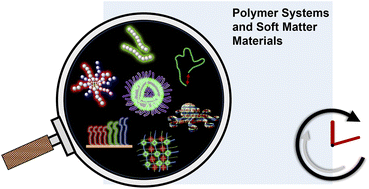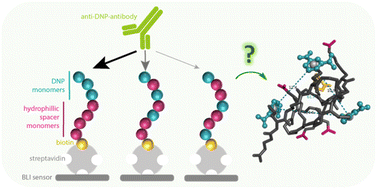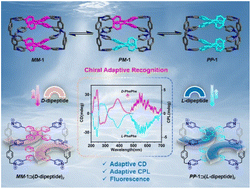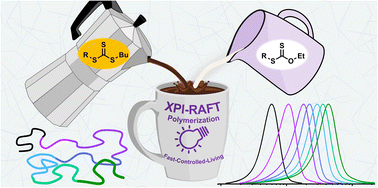Themed collection Most popular 2023 polymer and supramolecular chemistry articles

Sustainable formulation polymers for home, beauty and personal care: challenges and opportunities
As researchers, industries and consumers move towards more sustainable products there is a clear need to define what sustainability means in fast moving consumer goods and how it can be considered at the design stage.

Chem. Sci., 2023,14, 12926-12940
https://doi.org/10.1039/D3SC04488B
Picking the lock of coordination cage catalysis
We provide an overview of coordination cage catalysis, highlighting how mechanistic understanding can help address the challenges in this area leading to new opportunities in non-covalent reactivity.

Chem. Sci., 2023,14, 11300-11331
https://doi.org/10.1039/D3SC02586A
Magnetically controlled assembly: a new approach to organic integrated photonics
This perspective focuses on the development of organic hierarchical nanostructures based on magnetically controlled assembly methods, which are guided by the requirements of organic integrated photonics.

Chem. Sci., 2023,14, 8723-8742
https://doi.org/10.1039/D3SC01779F
Fluorescence-readout as a powerful macromolecular characterisation tool
We discuss the current state-of-the-art in exploiting fluorescence-based techniques for analysing polymer systems and soft matter materials, as well as provide an outlook on future opportunities and challenges.

Chem. Sci., 2023,14, 12815-12849
https://doi.org/10.1039/D3SC04052F
Recent advances in permeable polymersomes: fabrication, responsiveness, and applications
This work reviewed recent advances in the design, fabrication, and responsiveness of permeable polymersomes, and their diverse applications in the fields of biomimetic nanoreactors, artificial cells and organelles, as well as nanomedicine were highlighted.

Chem. Sci., 2023,14, 7411-7437
https://doi.org/10.1039/D3SC01707A
Circularity in polymers: addressing performance and sustainability challenges using dynamic covalent chemistries
This review provides a multidisciplinary overview of the challenges and opportunities for dynamic covalent chemistry-based macromolecules towards the design of new, sustainable, and recyclable materials for a circular economy.

Chem. Sci., 2023,14, 5243-5265
https://doi.org/10.1039/D3SC00551H
Pathway complexity in fibre assembly: from liquid crystals to hyper-helical gelmorphs
Pathway complexity results in unique materials from the same components according to the assembly conditions.

Chem. Sci., 2023,14, 11389-11401
https://doi.org/10.1039/D3SC03841F
Water-soluble polyphosphonate-based bottlebrush copolymers via aqueous ring-opening metathesis polymerization
Water-soluble and biodegradable polyphosphoester polymer bottlebrush copolymers and amphiphilic assemblies prepared by a combination of anionic ring-opening and metathesis polymerization.

Chem. Sci., 2023,14, 11273-11282
https://doi.org/10.1039/D3SC02649C
A visible-light-driven molecular motor based on barbituric acid
Yeehaw! The rotation of a visible-light-driven molecular motor based on barbituric acid is tamed by a hydrogen bonding “lasso” mechanism between its serendipitously-formed tertiary hydroxy stereocentre and its lower half carbonyl groups.

Chem. Sci., 2023,14, 8458-8465
https://doi.org/10.1039/D3SC03090C
Exploiting reduced-symmetry ligands with pyridyl and imidazole donors to construct a second-generation stimuli-responsive heterobimetallic [PdPtL4]4+ cage
A new method for the assembly of a heterobimetallic [PdPtL4]4+ cage which can interact with anionic guest molecules in a specific, selective host–guest orientation is described.
![Graphical abstract: Exploiting reduced-symmetry ligands with pyridyl and imidazole donors to construct a second-generation stimuli-responsive heterobimetallic [PdPtL4]4+ cage](/en/Image/Get?imageInfo.ImageType=GA&imageInfo.ImageIdentifier.ManuscriptID=D3SC01354E&imageInfo.ImageIdentifier.Year=2023)
Chem. Sci., 2023,14, 8615-8623
https://doi.org/10.1039/D3SC01354E
Tetrahomo corona[4]arene-based spirophanes: synthesis, structure, and properties
Racemic and enantiopure spirophanes and bispirophanes consisting of orthogonally configured tetrahomo corona[4]arene and i-corona[4]arene macrocycles were obtained and they displayed interesting tetrathiafulvalene binding and chiroptical properties.
![Graphical abstract: Tetrahomo corona[4]arene-based spirophanes: synthesis, structure, and properties](/en/Image/Get?imageInfo.ImageType=GA&imageInfo.ImageIdentifier.ManuscriptID=D3SC02417B&imageInfo.ImageIdentifier.Year=2023)
Chem. Sci., 2023,14, 8393-8400
https://doi.org/10.1039/D3SC02417B
Programmed guest confinement via hierarchical cage to cage transformations
A novel methodology based on the use of phenanthrenequinone is applied to selectively change the subcomponent of TPMA-based cages, thus controlling inclusion ratio of competing guests differing in size or chirality.

Chem. Sci., 2023,14, 8147-8151
https://doi.org/10.1039/D3SC01368E
Establishing PQ-ERA photoclick reactions with unprecedented efficiency by engineering of the nature of the phenanthraquinone triplet state
Thiophene substitution at the 3-position of PQ enhances its reactivity in PQ-ERA photoclick reactions, resulting in increased efficiency, yields, rate constants, and oxygen tolerance, offering prospects for efficient photoclick transformations.

Chem. Sci., 2023,14, 7465-7474
https://doi.org/10.1039/D3SC01760E
Dynamic covalent self-assembly and self-sorting processes in the formation of imine-based macrocycles and macrobicyclic cages
The self-assembly of imine-based dynamic covalent architectures involves component selection and self-correction processes to generate homo-self-sorted outputs, even in dynamic constitutional networks of high complexity.

Chem. Sci., 2023,14, 6631-6642
https://doi.org/10.1039/D3SC01174G
Sequence-defined antibody-recruiting macromolecules
Sequence-defined antibody recruiting macromolecules containing dinitrophenol as antibody-binding motif and biotin as terminal moiety, have been prepared and show sequence-dependent binding avidity to anti-DNP antibodies.

Chem. Sci., 2023,14, 6572-6578
https://doi.org/10.1039/D3SC01507F
Modulation of supramolecular chirality by stepwise axial coordination in a nano-size trizinc(II)porphyrin trimer
The work demonstrates unique chiral guest’s triggered spring-like contraction and extension motions coupled with unidirectional twisting upon successive coordination to a flexible and ‘nano-size’ achiral trizinc(II)porphyrin trimer.

Chem. Sci., 2023,14, 6032-6038
https://doi.org/10.1039/D3SC00858D
A data-driven sequencer that unveils latent “codons” in synthetic copolymers
Codons in synthetic copolymers—sequence-specific short segments encoding synthetic copolymer properties—became quantifiable via thermal fragmentation and virtual reconstruction based on unsupervised learning of pyrolysis mass-spectra.

Chem. Sci., 2023,14, 5619-5626
https://doi.org/10.1039/D2SC06974A
Rational design and topochemical synthesis of polymorphs of a polymer
We demonstrate the scope of combining polymorphism and topochemistry for the designed synthesis of polymorphs of a polymer. Polymorphs of a designed monomer underwent topochemical polymerization to polymer–polymorphs.

Chem. Sci., 2023,14, 5132-5140
https://doi.org/10.1039/D3SC00053B
Easily processable spin filters: exploring the chiral induced spin selectivity of bowl-shaped chiral subphthalocyanines
Herein a new class of spin filters based on subphthalocyanines is reported. We measure the CISS effect by means of magnetic conductive probe atomic force microscopy (mc-AFM). Remarkably, the resulting devices show spin polarizations (SPs) as high as ca. 50%.

Chem. Sci., 2023,14, 4273-4277
https://doi.org/10.1039/D3SC01069D
Lemniscular carbon nanohoops with contiguous conjugation from planar chiral [2.2]paracyclophane: influence of the regioselective synthesis on topological chirality
We report herein two lemniscular carbon nanohoops bis-po-CC and bis-pm-TC with contiguous conjugation from planar chiral [2.2]paracyclophane, and elucidate the influence of the regioselective synthesis on their topological chirality.
![Graphical abstract: Lemniscular carbon nanohoops with contiguous conjugation from planar chiral [2.2]paracyclophane: influence of the regioselective synthesis on topological chirality](/en/Image/Get?imageInfo.ImageType=GA&imageInfo.ImageIdentifier.ManuscriptID=D2SC06825G&imageInfo.ImageIdentifier.Year=2023)
Chem. Sci., 2023,14, 4426-4433
https://doi.org/10.1039/D2SC06825G
Degradable polyisoprene by radical ring-opening polymerization and application to polymer prodrug nanoparticles
Radical ring-opening copolymerization of isoprene and dibenzo[c,e]oxepane-5-thione via free-radical and controlled radical polymerizations led to degradable polyisoprene under basic, oxidative and physiological conditions with application to prodrug nanoparticles.

Chem. Sci., 2023,14, 3311-3325
https://doi.org/10.1039/D2SC05316K
Experimental and theoretical elucidation of SPAAC kinetics for strained alkyne-containing cycloparaphenylenes
Strained alkyne-containing cycloparaphenylenes unite curved carbon nanomaterials with tunable reactivity via physical organic chemistry. Herein we describe the rational design and synthesis of new derivatives with heightened SPAAC reactivity.

Chem. Sci., 2023,14, 2839-2848
https://doi.org/10.1039/D2SC06816H
Acceptor engineering of metallacycles with high phototoxicity indices for safe and effective photodynamic therapy
Acceptor engineered supramolecular photosensitizers with a proming phototoxicity index (PI) for effective and safe photodynamic therapy in vivo.

Chem. Sci., 2023,14, 2901-2909
https://doi.org/10.1039/D2SC06936A
A folded π-system with supramolecularly oriented dipoles: single-component piezoelectric relaxor with NLO activity
We have shown that organic folded structures can be utilized to elicit piezo-, ferroelectric and efficient second harmonic generation – all within a single component, macroscopically dipole active system.

Chem. Sci., 2023,14, 2547-2552
https://doi.org/10.1039/D2SC06141D
Maximized axial helicity in a Pd2L4 cage: inverse guest size-dependent compression and mesocate isomerism
The extreme axial twist of a Pd2L4 cage facilitates tight encapsulation of mono-anions through prolate-oblate cavity adaptation. In the absence of a suitable guest, the helical cage exists in equilibrium with an ‘unwound’ mesocate isomer.

Chem. Sci., 2023,14, 1524-1531
https://doi.org/10.1039/D2SC06629G
Construction of multiphasic membraneless organelles towards spontaneous spatial segregation and directional flow of biochemical reactions
The bottom-up construction of multiphase droplets with structural and functional mimicry of intracellular organelles, capable of spatiotemporal confinement and coordination of complex reaction networks.

Chem. Sci., 2023,14, 801-811
https://doi.org/10.1039/D2SC05438H
Individually separated supramolecular polymer chains toward solution-processable supramolecular polymeric materials
Herein, we present a simple design concept for a monomer that affords individually separated supramolecular polymer chains.

Chem. Sci., 2023,14, 822-826
https://doi.org/10.1039/D2SC06089B
Chiral adaptive recognition with sequence specificity of aromatic dipeptides in aqueous solution by an achiral cage
An achiral TPE-based cage with the dynamic rotational conformation exhibits chiral adaptive recognition with sequence specificity for aromatic L-/D-dipeptides to achieve adaptive CD and CPL responses in aqueous solution.

Chem. Sci., 2023,14, 833-842
https://doi.org/10.1039/D2SC05854E
Inherently chiral calixarenes by a catalytic enantioselective desymmetrizing cross-dehydrogenative coupling
Reported here is the catalytic enantioselective desymmetrization of calixarene skeletons for the construction of inherently chiral calixarenes through a transannular arene–arene dehydrogenative coupling reaction.

Chem. Sci., 2023,14, 827-832
https://doi.org/10.1039/D2SC06234H
Xanthate-supported photo-iniferter (XPI)-RAFT polymerization: facile and rapid access to complex macromolecules
The addition of small amounts of xanthate can turn conventional RAFT polymerizations into rapid photo-activated reactions with high livingness, oxygen tolerance and versatility enabling straightforward multiblock synthesis or well plate screening.

Chem. Sci., 2023,14, 593-603
https://doi.org/10.1039/D2SC05197D
About this collection
This specially curated collection pulls together some of the most popular articles from 2023 in the fields of polymers and supramolecular chemistry. The collection presents some outstanding contributions to the field, including sequence-defined antibody-recruiting macromolecules and tetrahomo corona[4]arene-based spirophanes. As with all Chemical Science articles, this collection is completely free to access and read. We hope you enjoy browsing through this collection.
If a particular article has inspired you, do feel free to share on social media using the buttons on each article landing page and use our hashtag: #ChemSciMostPopular